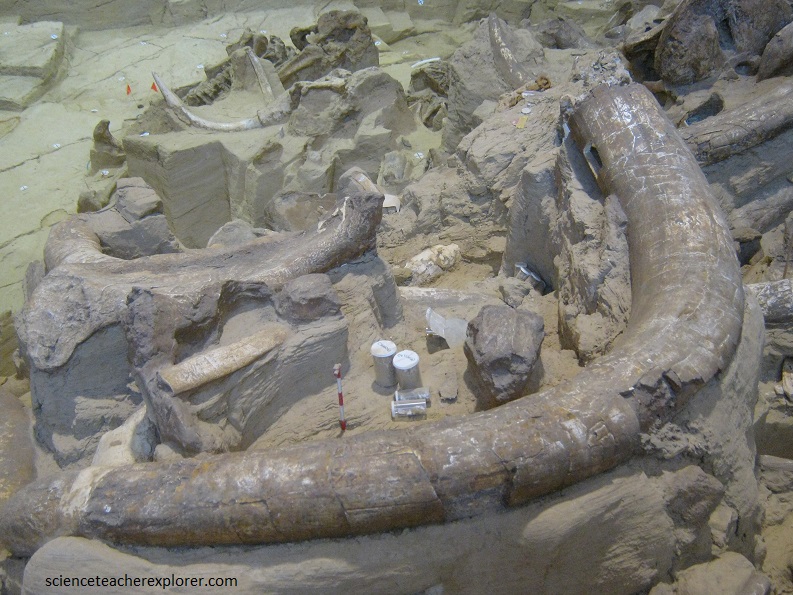Mammoth Site SD 2012
In July of 2012, I found myself exploring South Dakota. While there, I visited the Mammoth Site in Hotsprings.

The Mammoth Site of Hot Springs, SD is an active paleontological dig site, which boasts the largest concentration of mammoth remains in the world! The current mammoth count is 61, with 58 Columbian and 3 woolly mammoths.

The area of Mammoth Site of Hot Springs enclose a prehistoric sinkhole that formed and was slowly filled with sediments during the Pleistocene era. The sedimentary fill of the sinkhole contains the remains of Pleistocene fauna and flora preserved by entrapment and burial within a sinkhole.

Pictured above, three different but gradual episodes of sedimentation filled the sinkhole over a period of approximately 750 years. During the Late Pleistocene, the sinkhole at Mammoth Site of Hot Springs formed when a cavern in the Minnelusa Limestone collapsed. This cavern collapse created a steep-sided sinkhole, that was about 20 m deep and 37 m by 46 m wide at the surface within a Pleistocene terrace underlain by Spearfish Shale. The sinkhole is the surface expression vertical breccia pipe provided a chimney-like path that allowed warm artesian water to percolate upward and fill the sinkhole with a steeply-sided pond.

Likely enticed by warm water and pond vegetation, mammoths entered the pond to eat, drink or bathe. Because of the steep sides of very slippery Spearfish Shale, mammoths were occasionally trapped as they were unable to find a foothold and climb out of the sinkhole during periods of low water. Trapped in the sinkhole, the mammoths ultimately died of starvation, exhaustion, or drowned in the pond. Cross-section of mammoth footprints at the Mammoth Site. Eventually the sinkhole filled, and the artesian spring diverted to the lower elevation of Fall River, as the river cut deeper in the valley floor. Over thousands of years, the “hardened mud plug” inside the dried-up pond has remained stable. The surrounding sediment was subsequently eroded, leaving the sinkhole as a high point on the landscape.

This site has the greatest concentration of mammoth remains in the world. Evidence of three woolly mammoths have also been discovered here, making this “east meets west mammoth gathering” the first time both species have been found together. Not petrified, these fossils are dry and fragile. The bones, scat and shells are identified, numbered cataloged and preserved, with almost all the mammoth remains displayed in-situ (as they were found in the sinkhole).

Fossils of other Ice Age animals have also been discovered: camel, llama, giant short-faced bear, wolf, coyote and prairie dog to name a few. Imprint fossils of bird feathers, complete fish skeletons, and thousands of mollusk shells have also been recovered from this now-dry 26,000 year old sinkhole.

This 26,000 year estimate was made on the basis of the faunal remains that are found in association with the mammoth remains. The presence of the remains of Pleistocene bear, camel, antelope, and shrub-ox indicated to geologists and paleontologists that sinkhole at this site might be filled with Late Pleistocene, possibly terminal Pleistocene, sediments. Pictured below, the Hot Springs Giant Short-Faced Bear, was an adult male, in the prime of life. Thus far, they have discovered no trauma, or cause of death for this individual. He may have tried to dine on a not-so-deceased mammoth and was crushed by his intended meal ticket. Detailed studies of these bones and teeth at this site, have led researchers to conclude the short-faced bear was a large (1.5 m in a quadrupedal stance), opportunistic scavenger which occupied the open grasslands.

What caused the extinction of the Mammoth. I found an educational interpretive site that summarizes the current theories. Since they are presented at the Museum of the Mammoth Site in Hotsprings, South Dakota; it makes them public domain and below are images of the theories.




All mammoths in North America became extinct about 11,000 years ago. On Wrangel Island, in the Siberian Arctic Ocean, a population of wooly mammoths survived until 4000-3700 years ago. Pictured below, is an example of the remains of one them.
